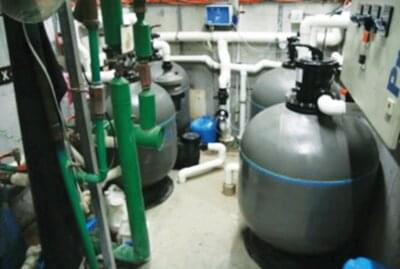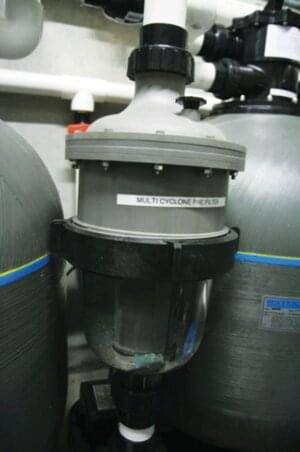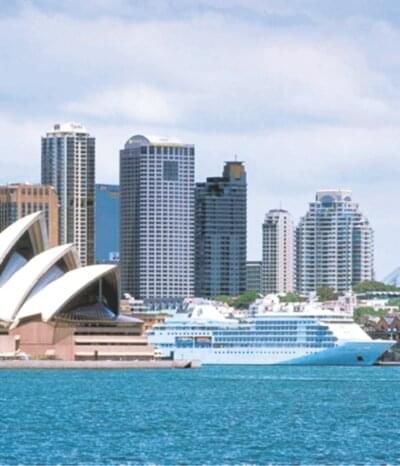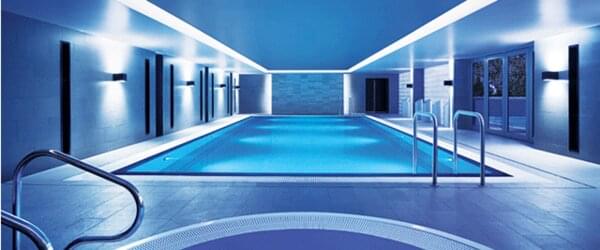Australian designed MultiCyclone filtration system the preferred choice for five-star hotel
"We have never seen the pool water clarity look so good." Shangri-La Sydney, chief engineer, Russell Allom
- Multicyclone pre-filters up to 80% of pool’s dirt load before it reaches filter
- Deep filter bed filters out finer dirt particles and colloidal substances
- Reduced backwashing leads to significant water and power savings
Challenges
Shangri-La Hotel Sydney’s 15-metre lap pool was not meeting hotel engineer’s expectations due to an ageing filtration system installed in 1992. As a result, pool water clarity was substandard and the filters required frequent backwashing due to an ever-increasing swimming load.
The swimming pool has a volume of 90,000 litres with a surface area of 75m2 and an average depth of 1.2m. Hotel management needed to improve the pool water turn over rate to at least every two hours. To achieve this, a flow rate of 45m3/hr or 750lpm was required.
In addition, the pool’s plant room door only measured 800mm wide, thus limiting the options for a larger sized commercial filter. The existing filtration plant consisted of two 750mm diameter sand filters plumbed with 40mm pipe to two, two horse power pumps.
Solution
To achieve a turn over rate of two hours, Russell Fagan and Brad Weir from Steel Pty Ltd sized up four Micron SD750 fibreglass wound filters, with two high head Hydrostorm plus 200 pumps, and two MultiCyclone centrifugal pre-filters.
Each Hydrostorm plus 200 pump was plumbed to one MultiCyclone filter and the flow was split between two Micron SD750 filters. The Micron deep bed filters were chosen over standard Micron filters.
The deep bed filters have a filter media bed depth of 500mm, providing enhanced indepth filtration and increased dirt capacity. The effect of deep filter media bed improves the filtration efficiency over standard high-rate filters. The filter’s 500mm filter media bed also ensures that finer dirt particles and colloidal substances are retained to a far greater level than standard bed depth filters. Additionally, the greater bed depth permits the efficient use of a mixed filter media bed.
The gravel formed an underlay around the filter’s laterals improving the hydraulic efficiency of the filter and Garnet was added to provide a superior level of filtration. The mixed filter media bed of sand, garnet and gravel at a low filtration velocity is capable of filtering effectively down to 5 microns (0.005mm). A high rate filter media bed is only capable of filtering down to 30 microns (0.03mm).
Water flow from the pump was split between each sand filter at approximately 187 litres per minute. This flow rate was nearly half the flow rate of the former filters, equating to a low filtration velocity of 25.5 m3/hr/m2.
A low filtration velocity vastly improves the contact time of the pool water with the filter media and enables the filter’s media bed to capture finer particles.

Four Micron SD750 fibreglass wound
filters, with two high head Hydrostorm
plus 200 pumps, and two MultiCyclone
centrifugal pre-filters.

MultiCyclone filters up to 80% of the
pool’s dirt load before it reaches the
pool filter.
Benefits
Russell Allom, Shangri-La Sydney’s chief engineer saw an immediate improvement once the filtration plant was turned on. “We have never seen the pool water clarity look so good,” he says.
To backwash the filters, the full flow of the pump is dedicated to each filter one at a item, producing a filtration velocity of 50 m3/hr/m2 to thoroughly expand the filter media and release its trapped contents. A high flow velocity improves the filter media bed expansion, minimises the amount of water utilised during each backwash and also decreases the frequency between backwashes.
MultiCyclone pre-filters were installed above each pump, to pre-filter incoming particles to reduce the dirt load on each filter, further reducing filter maintenance and vastly reducing backwash requirements leading to significant water savings.
Based on the principals of centrifugal water filtration, MultiCyclone filters up to 80% of the pool’s dirt load before it reaches the pool filter. There are no moving parts to wear and tear, and no filter media to clean or replace.
Incoming water enters 16 hydro cyclones tangentially, generating a strong centrifugal effect. The sediment is spun out to the hydro cyclone’s wall, and then spirals down to the sediment chamber. The filtered water migrates towards the centre of the hydro cyclone where the flow reverses and spirals upwards through the outlet. Accumulation of sediment IS easily monitored via the MultiCyclone’s clear sediment chamber, while opening its purge valve easily cleans the filter. Only 15 litres of water is discharged to cleanse the chamber.
“During the first month of operation, I could not believe the amount of material captured by the MultiCyclone prior to the sand filters,” said Russell. “The former filters required backwashing on an average of every two days, which was both time consuming and costly.
“The installation of the MultiCyclone pre-filters has greatly reduced the backwashing frequency to approximately every ten days, resulting in significant water savings,” he says.
About Shangri-La Hotel Sydney
With stunning views of Sydney’s spectacular Harbour, the Sydney Harbour Bridge and the world-famous Opera House, the Shangri-La Hotel, Sydney brings welcoming Shangri-La hospitality to the historic Rocks district in the heart of Australia’s busiest city.
For health-conscious travellers, the Shangri-La Hotel, Sydney offers a Health Club with a fully equipped gymnasium, indoor lap swimming pool, jacuzzi and sundeck.

